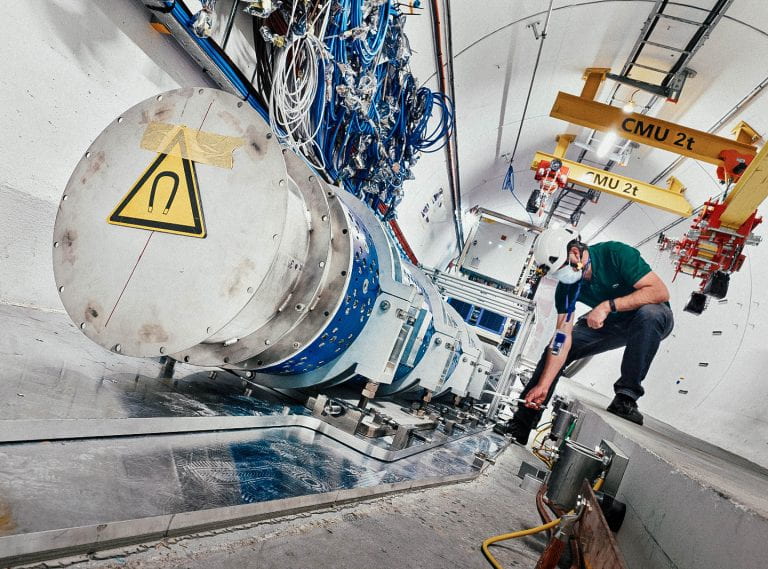First observation of collider neutrinos by FASER
News, 22 March 2023
The FASER international collaboration has detected neutrinos obtained at the collider at CERN for the first time. The discovery promises to deepen scientists’ understanding of the nature of neutrinos, first spotted in 1956, which are the most abundant particle in the cosmos and play a key role in the process that makes stars burn. The work could also shed light on cosmic neutrinos that travel large distances and collide with the Earth, providing a window on distant parts of the cosmos.
“We have discovered neutrinos from a brand-new source, particle colliders, at which two beams of accelerated particles smash together at extremely high energy,” said Jonathan Feng, a particle physicist at the University of California, Irvine and Co-Spokesman of the FASER Collaboration which now involves over 80 researchers at 22 institutions including JINR. The FASER (Forward Search Experiment) particle detector is installed at CERN, the European Council for Nuclear Research, at which specialists detect particles produced by the Large Hadron Collider.
The FASER collaboration announced the results at the 57th Rencontres de Moriond Electroweak Interactions and Unified Theories conference in Italy.
Scientists of the Laboratory of Nuclear Problems are JINR participants in the experiment. They have extensive experience in experiments in neutrino physics, in particular in the OPERA experiment.
“In OPERA, specialists used nuclear photoemulsion to detect neutrinos. FASER also has a photoemulsion subdetector (FASERnu) aimed at neutrino detection at the LHC. The JINR team is involved in signal simulation, reconstruction and analysis of photoemulsion data, design and development of the cooling system with the possibility of controlling and stabilizing temperature for the FASERnu,” Svetlana Vasina, a researcher of the Sector of Experimental Neutrino Physics, a JINR participant in the FASER collaboration, explained.
Scientists have already known neutrinos for several decades. They were very important for establishing of the Standard Model of Elementary Particle Physics. However, until now, no neutrino produced at a collider has ever been detected by any experiment.
JINR scientists’ contribution to neutrino physics takes its start from experiments perfomed by Bruno Pontecorvo. Until now, the majority of neutrinos studied by physicists have been low-energy neutrinos. However, neutrinos detected by FASER are the highest energy ever produced in a lab. They are similar to the neutrinos found when deep-space particles trigger dramatic particle showers in our atmosphere.
“They can tell us about deep space in ways we cannot learn otherwise,” Jamie Boyd, a particle physicist at CERN, said. “These very high-energy neutrinos produced by the LHC are important for understanding really exciting observations in particle astrophysics.”
FASER is new and unique among particle-detecting experiments. Unlike other detectors at CERN, such as ATLAS, which stands several stories tall and weighs thousands of tons, FASER is about one ton and fits neatly inside a small side tunnel at CERN. Это позволило разместить его в небольшом вспомогательном тоннеле ЦЕРНа. Moreover, it took only a few years to design and construct it using spare parts from other experiments.
In addition to detecting neutrinos, FASER is also aimed at detecting particles of dark matter, which physicists think comprises most of the matter in the universe. However, they have never been directly observed. FASER has yet to find signs of dark matter. However, with the LHC run to begin a new round of particle collisions in a few months, the detector is ready to record them, should they appear.
Previously, the FASER Collaboration has already reported on a few collider neutrinos registered by its nuclear emulsion detector. The new result is based on large statistics of detected very high energy neutrinos at the FASER electronic detector. Its statistical significance exceeds 16 sigmas.
 The FASER particle detector, located deep underground at CERN’s Large Hadron Collider, was mostly built out of spare parts from other experiments at CERN such as the ATLAS project. Photo: @FASER
The FASER particle detector, located deep underground at CERN’s Large Hadron Collider, was mostly built out of spare parts from other experiments at CERN such as the ATLAS project. Photo: @FASER